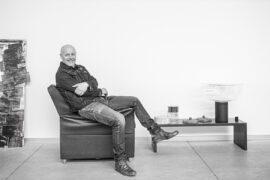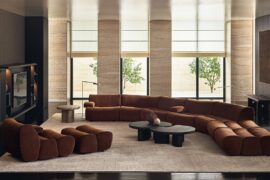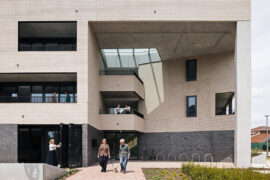Baroque architecture is an extravagant design movement which swept through Europe across the 17th century

August 22nd, 2022
What is Baroque architecture and when was the Baroque period?
Baroque architecture is a style of architectural dramatism which began in early 17th century Italy. The Baroque period was a time between 1600-1700 in Western Europe with a distinct style of art, music, architecture and design.
Baroque architecture is characterised by grandness, with extremely theatrical and decorative design choices. This was achieved through contrast – particularly in lighting – dizzying, sweeping shapes, vivid colours and elaborate paintings, illusionary effects, and gilded decorations.
What does baroque mean?
Baroque architecture is loud and triumphant, with ornamentation and detail which announces its historical origin. Its characteristics of decorative maximalism and irregularity has seen it often characterised as bizarre, asymmetrical, or exuberant.
This was also reflected in the art and music of the Baroque era, which was named “Baroque” as a derivation from the Portuguese word barroco or “strange pearl.”
Development of Baroque architecture
The origin of Baroque architecture is inherently tied to the Catholic Church. The first appearance of Baroque architecture can be traced to late 16th and early 17th century Rome, where it emerged as a reaction against the rigidity of earlier religious architecture during the Protestant Reformation. It was quickly adopted by new religious orders and became characteristic of the Theatines and the Jesuits in a strategy to inspire common people with awe at their religious power. Baroque architecture came into style slightly after the Renaissance period.
Carlo Maderno is one of the earliest celebrated Baroque architects who pioneered developments of space and perspective in exterior façade design. His redesign of the façade and colonnades of Saint Peter’s Basilica was in direct contention with artist Michelangelo’s earlier constructed dome, creating a dizzying contrast between order and entropy.
Baroque architecture is inherently linked to the spread of colonialism throughout the globe. The emergence of Baroque design coincided with the expansion of the European empire. Though it originated in Italy, Baroque style spread to all areas of Western Europe and eventually their colonized territories. This is partially why Spain is such an important cultural hub of Baroque architecture, because during the Baroque period Spain was one of the primary holders of colonial wealth.

Popularity
The Baroque architectural movement ground to a halt in around 1720, replaced by the even more extravagant style Rococo in France and eventually the rest of Europe. Baroque architecture endured for many more years in certain regions, holding a firm stronghold in Germany and colonial South America well into the 18th century.
However like many architectural styles, Baroque has seen a few revivals since its original demise. Neo-Baroque architecture emerged in the late 19th century as a revivalist movement which aimed to keep central characteristics of Baroque architecture intact – such as the elegance, whimsy, and unpredictability – but incorporate modern designs and materials.
An even more contemporary revival is the development of new Baroque style buildings in the 21st century. In many places, architecture is showing the subtle influence of Baroque design values, with buildings becoming dramatic and elaborate once again rather than the industrial chic which has held precedence for years.
To understand more about Baroque buildings (both historical and neo-Baroque) browse the list below.
6. The National Museum of Australia

The National Museum of Australia (NMA) is located in Acton, Canberra and remains one of the best modern examples of Neo-Baroque architecture. It was completed on the 11th of March, 2001 and designed by architect Howard Raggatt.
Though the NMA also exhibits elements of deconstructivism in design, there are many features which can be identified as undeniably Baroque in origin. For one, the bold and colourful exterior catches the eye as many traditional Baroque buildings aspired too. Secondly, the NMA makes use of illusory architectural motifs with inventive shapes and designs – staying true to the bizarre nature of the baroque period. Read more about the National Museum of Australia here.
5. Royal Palace of Madrid

Completed on the 7th of April 1735, the Royal Palace of Madrid is now 287 years old. It took 16 years to complete. Its first resident was Charles III, who was known colloquially as the ‘Mayor of Madrid’ due to the high number of reforms that he initiated.
The original architect Filippo Juvarra, who was heavily influenced by Italian Baroque architect Gian Lorenzo Bernini, who had a heavily Florentine style. The geometric rigor and square plan layout is extremely typical of Spanish Baroque style.
4. St Charles Church

Also known as Karlskirche, the St Charles Church is easily the most iconic example of Baroque architecture in Vienna. Construction finished in 1737, making Karlskirche 285 years old. The church was built in dedication to the celebrated healer Saint Charles Borromeo, who worked to alleviate the suffering of those infected with plague.
3. Royal Palace of Caserta

Easily the most elaborate building in Southern Italy, the Royal Palace of Caserta is the largest royal residence in the world at over 2 million metres cubed and spread over a mass of 47,000 metres squared.
The Royal Palace of Caserta was built in 1752 to architect Luigi Vanvitelli for King Charles of Bourbon. Construction took more than fifty years and the project cost the equivalent of 330 billion Euros today.
2. St Paul’s Cathedral

St Paul’s Cathedral is one of London’s most ionic cathedrals which has hosted a great many historical events since its 1675 construction. From the sheer scale to elaborate furnishing, the cathedral announces its Baroque heritage with every square foot.
1. The Palace of Versailles

The Palace of Versailles is without a doubt the most prominent standing product of traditional Baroque architecture. The building originally began as a simple hunting lodge before it was replaced by a small chateau in the 1630s and later rebuilt into the grand example of Baroque architecture open for visitation today.
The Palace of Versailles is listed as a World Heritage Site and has held that title for 40 years. It was the principle residence of the majority of French royalty from the era of Louis XIV to Louis XVI. The palace stands today as a symbol of the grand power royalty inspires and the virtually limitless potential of decadent architecture.
INDESIGN is on instagram
Follow @indesignlive
A searchable and comprehensive guide for specifying leading products and their suppliers
Keep up to date with the latest and greatest from our industry BFF's!

For a closer look behind the creative process, watch this video interview with Sebastian Nash, where he explores the making of King Living’s textile range – from fibre choices to design intent.

London-based design duo Raw Edges have joined forces with Established & Sons and Tongue & Groove to introduce Wall to Wall – a hand-stained, “living collection” that transforms parquet flooring into a canvas of colour, pattern, and possibility.

We caught up with Abramo Manfrotto, CEO of Venetian decorative lighting brand LEUCOS, during a visit to Australia with dedece.

Arper expands its outdoor offer by re-engineering some of its most recognisable indoor pieces for life outside.

Poliform has mastered the art of seating that is both elegant and adaptable. These five designs highlight the balance between aesthetic impact and everyday ease.

Hospitality is evolving fast, demanding interiors that can flex as quickly as guest expectations. From modular seating to stackable silhouettes, Bowermans brings global design brands and local know-how to help designers shape spaces that perform as well as they inspire.
The internet never sleeps! Here's the stuff you might have missed

Bangalore studio Multitude of Sins elevates true leftovers — not surplus — into a richly layered workspace where waste materials become narrative, structure and sculptural expression.

Brett Ward, General Manager of Marketing at Brickworks, tells us how modern approaches to sustainability are intersecting with the long history of the brick.